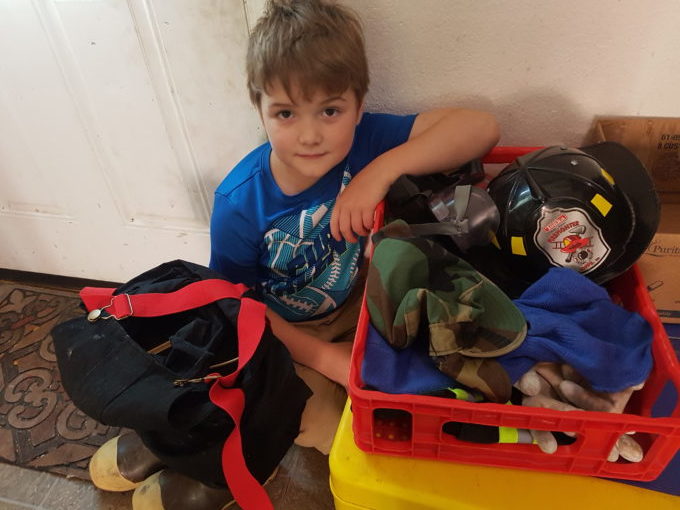
Nathan uses this crate to fold and store his gear.
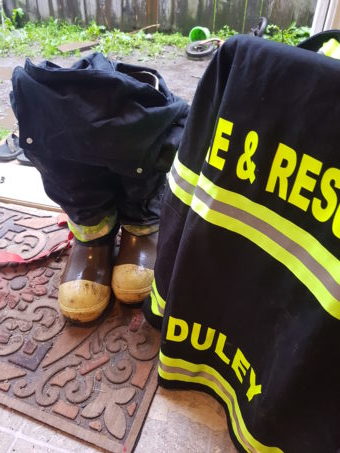 This unit has certainly had more substance than the introductory Unit. It has included reading about and discussions on a firefighter’s need to insure their own personal safety and the safety of their team through healthy personal habits, safety during training and through good training, and while on the job and using equipment.
This unit has certainly had more substance than the introductory Unit. It has included reading about and discussions on a firefighter’s need to insure their own personal safety and the safety of their team through healthy personal habits, safety during training and through good training, and while on the job and using equipment.
We talked about the need for good sleep, a healthy diet, and exercise. There was a big emphasis on the importance of keeping hydrated before you feel thirsty and before you work-out, and then also while you work, and during rehabilitation, (which will be touched on in great lengths in Unit 13). Obviously for CF reasons and general health smoking is strongly ill-advised, but many fire departments don’t allow their crews to use tobacco, so it was a great reinforcement.
One specific area we spent extra time discussing was the need for personal safety while driving and arriving on an apparatus. You would not believe the number of fireman who do not wear their seat belt in transit! We also looked at intersections to see the many ways in which a vehicle, (especially one in a hurry that is passing through a red light,) might get into an accident. Then there is the need for reflective vests and common sense when working along-side traffic.
All of the above mentioned areas of safety are not only crucial for fireman and other rescue workers, but very much applicable to everyday life for each of us as civilians.
And lastly, as it is pretty obvious that thinking smart and acting purposefully and safely on the scene of an emergency is essential, the act of safe habits and properly executed skills while in training are what lead to the safety and well being of fighters while on site. Sloppy skills, or injuries sustained during training can have a huge affect on the efficiency of the team when the real emergency arises.
After our time studying general personal safety we went into the details of the Personal Protective Equipment (PPE) worn for structural fire fighting. It was fun to put together a cheap available rendition of each piece, and Nathan continues to have a really great time donning and doffing his gear; both for practice drills, as well as in simulated play. The reasoning and need for each of these items is pretty self explanatory and it’s fun, so the learning here is quite easy. A trip to fire station can really bring the subject to life and give a child the opportunity to share their understanding of the turn-out gear, as well as what the Personal Alert Safety System (PASS) looks and sounds like.
Learning about the Self Contained Breathing Apparatus (SCBA) is a little more abstract in that most of us will not have the opportunity to try on a real one, and even just carrying the tank pack itself, for how heavy it is, can be a huge challenge for most elementary-age children for any prolonged period of time. You can see then why we made a smaller rendition for Nathan. He loved the challenge and it was very good for building strength and endurance. Those are all shown in more detail below.
Here is a video of one of his training sessions. We have since learned a better way to load the SCBA pack, by throwing it upside-down over his head. Using this technique you aren’t stuck blindly fumbling for straps. It is a huge time saver.
As far as projects, we started Nathan’s “Fire Fighter Training Manual” by adding pages that include some hand written general guide lines and the mission of the fire department with drawings, as well as the first chapter which includes photos of each part of his PPE that he can label. Eventually we will laminate each page and bind it. It will be a helpful review for him as he learns each skill, and of course great for his reading and writing skills, but also a wonderful keep-sake for when he is older.
Here is a list of the resources and pages we used for Unit 2.
These and other helpful resources are discussed in more detail on the Orientation Page, while this year’s School Year Plan Page outlines (with links as we go along) each of the units we will cover.
- Personal Safety:
- Fundamentals of Fire Fighting Skills (third edition)
- Various parts of pages 27-29, 31-34, and 38
- Fundamentals of Fire Fighting Skills (third edition)
- PPE:
- Fundamentals of Fire Fighting Skills (third edition)
- Various parts of pages 44-49, and 50-51
- Skill Drills 3-1 and 3-2
- Fundamentals of Fire Fighting Skills (third edition)
- SCBA:
- Fundamentals of Fire Fighting Skills (third edition)
- Various Parts of pages 54-55, 56, 58, 62-65
- Skill Drill 3-5
- Fundamentals of Fire Fighting Skills (third edition)
- REVIEW: Barron’s Firefighter Exams: 6th Edition:
- PPE and Safety: Pages 109-10, 364-5, 470
You may wish to include some more study about Safe Driving Practices, as this certainly pertains to Personal Safety, however it also fits quite nicely with ‘Unit 10: The Truck.’ I’ve included it here as well as there for your choosing:
- Driving Privilege, and Safe and Defensive Driving:
- “Fire Service Pump Operator Principles and Practice”
- Various Parts of pages 206-212, 9-12, 94, and 196-97
- REVIEW: “Barron’s Firefighter Exams: 6th Edition”
- Pages 393, 396, 418, 462-3, and 472
- “Fire Service Pump Operator Principles and Practice”
Here is the set of mock-up PPE we have put together for Nathan:
This Kid’s Turnout Gear is awesome! It can be customized with a city and name, and is made of great material. It even has wristlets.
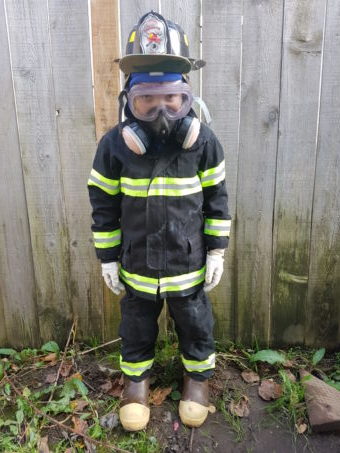
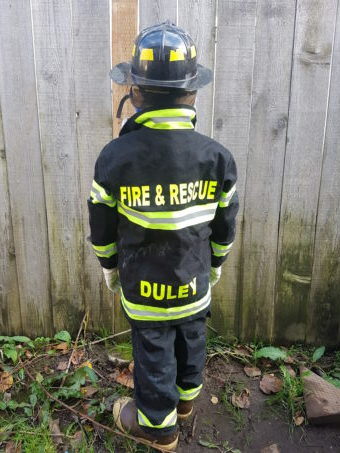
We use a kids fireman helmet and I duct taped some felt to the inside for nice looking ear-flaps. At first we were using an additional hat (you can see it below) and it looked really dorky. This was an easy and cheap fix.
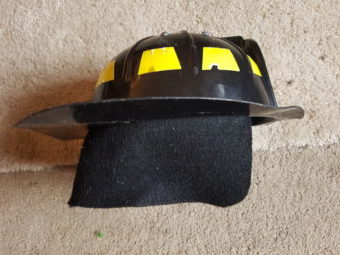
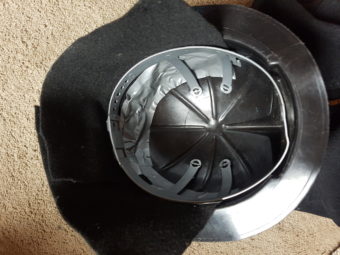
For a respirator we used an old construction mask. We lost the head straps for it and messed around with taping it but eventually I zip-tied it to the goggles and it worked like a charm! Full face masks were out of our budget for this mock-up.
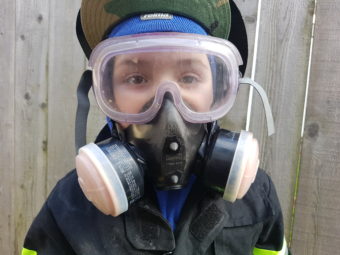
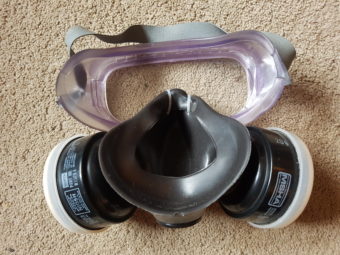
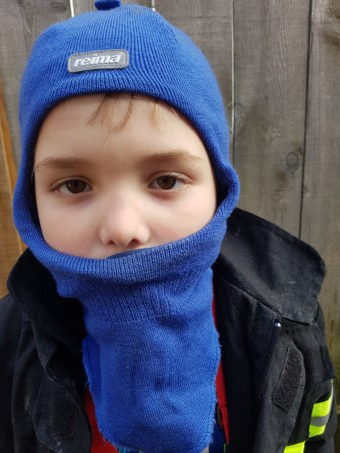
We started using this ski mask that was borrowed from a daycare friend. It worked very well, but I have ordered Nathan his own hood, something thinner, and I am impatiently awaiting it’s arrival! It will also be useful for daily life. They have it in red and neon green, too!
Gloves and Boots are pretty straight forward. Nathan was giving an over sized pair of Extra Tuffs which work great, and for now these small grippy gloves have been working well, but again, I ordered an update for his set, a pair of orange and black ones that were a cheap add-on item on Amazon.
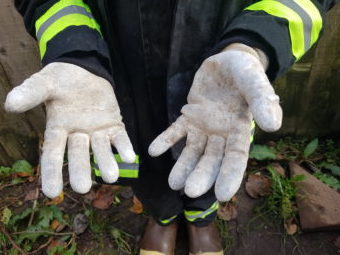
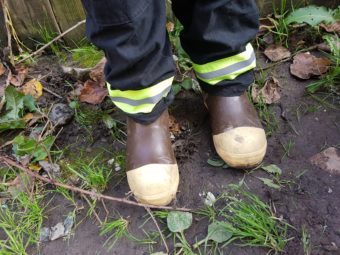
After we got the basics put together we worked on a tank pack. I simply emptied a camel-pack back-pack and we filled various empty soda bottles with sand. Nathan can pick how heavy he wants to pack to be. Lastly we use an old hose from his nebulizer to simulate the attachment to the mask.
As for the PASS we pretend that the walkie-talkies are the PASS, and simply push the call button to ‘turn it on,’ and then we also use the walkie-talkies for communications.
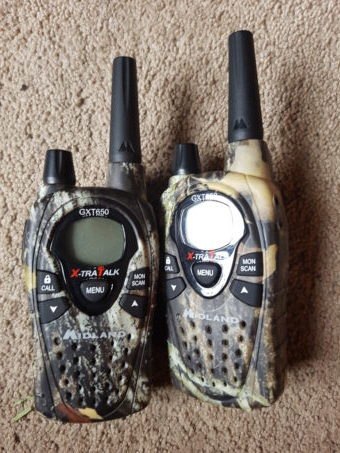
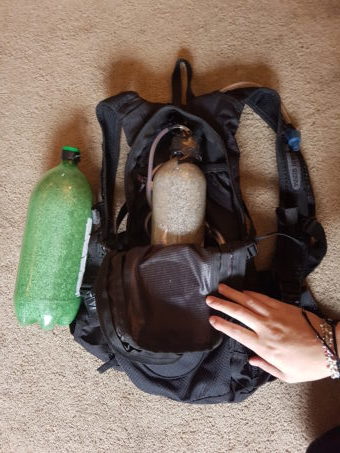
For the next unit we are going to move into Communications and talk about the Incident Command Center. It’s not a huge unit, but with a hopeful visit to Dispatch and an interview with a real dispatcher it should prove to be very informative for all of us!
I hope you have the chance to follow us along, and feel free to look up Semiserious Chefs on your favorite form of social media!


Post a comment